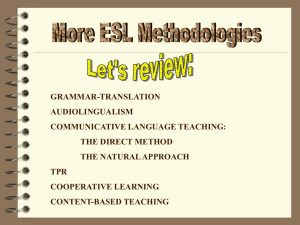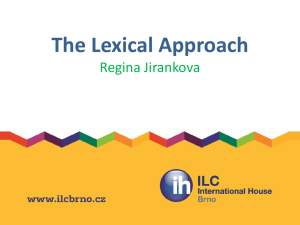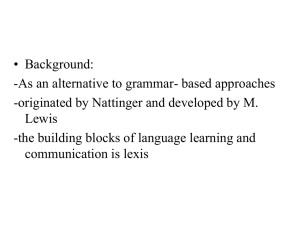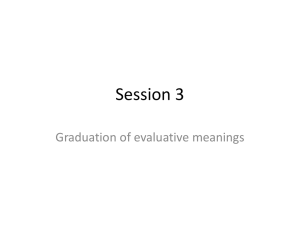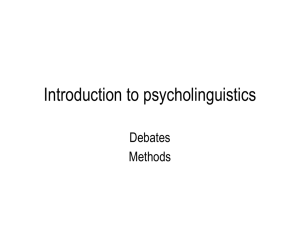dis
advertisement
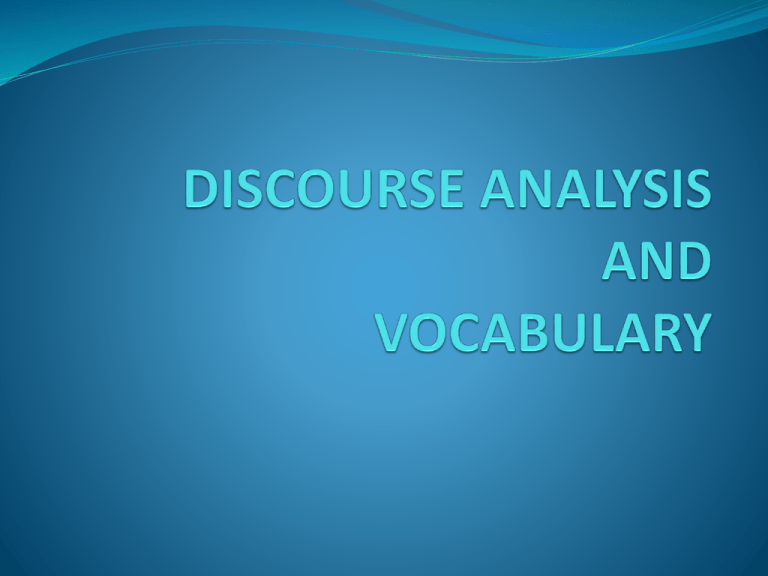
Bring a discourse dimention to teach vocabulary Not abandoning vocabulary teaching, instead offering a supplement to conventional vocabulary teaching Using traditional and recent, more communicative approaches in vocabulary teaching and activities Lexical Cohesion Repetiton of words and the role played by certain basic semantic relations between words in creating textuality. Reiteration: either restating an item in a later part of the discourse by direct repetition or else reasserting its meaning by exploiting lexial relations. Hyponymy (rose-flower/ chair-furniture) Synonymy (commence-begin) Reiteration Is extremely common in English discourse, Adds new dimensions and nuances to meaning, Serves to build up increasingly complex content. Implications for language pedagogy Disturbing the lexical patterns of texts may lead to unnaturalness and inauthenticity at the discourse level. Simplification may mean unnatural amount of repetition. Observing lexical links in a text could be useful for language learners in various ways. Lexical reiteration supplies learners with meaningful, controlled practice and chances to improve their textcreating and decoding abilities by providing more varied contexts for using and practising vocabulary. Lexis in talk Lexical relations can be applied to spoken data as well. Relexicalisation: speakers reiterate their own and take up one another’s vocabulary selections in one form or another from turn to turn and develop and expand in doing so. The connection between development and modification and reworking of lexical items used before makes the conversation develop coherently. In this way, neither side is dominant in the conversation, which makes the conversation a joint activity (ethnometodological approach to D.A.). Relexicalisation of some elements provides aggrement and contribution to relevance. Conversation classes where topics are pre-set may be very suitable for this kind of development. As the transition from superordinates to hyponyms and from synonyms to antonyms is a common feature of conversation, students can be equipped to use this skill by regular practice. As soon as the necessary vocabulary is met, language learners can be encouraged to use communicative value of these lexical items at an early stage. Textual aspects of lexical competence Sometimes our expectations as to how words are conventionally used are disturbed when the writers arrange usual lexical relations for particular purposes of the text. The depressing feature of Allen’s documents is the picture which emerges of smart but stupid military planners, the equivalent of America’s madder fundamentalists, happily playing the fool with the future of the planet. ( The Guardian, 13 November 1987: 15) There are other readjustments of lexical items which are valid in particular texts only. Their interpretations may not correspond to dictionary definitions. The good listener/reader has to decide when words are being used as synonymous or when these same words are used to stress the difference in meaning-potential. Discourse-specific lexical relations can be called instantial relations (J. Ellis, 1966). Although these relations frequently found in texts in all languages, the problems learners encounter with such uses are usually psychologically-generated. Because they come to texts with the expectations that the words have fixed relationships with one another. Instantial relations often present important stylistic features in text: Creative lexical usage, Devices of evaluation or irony, Particular focus. By definition, each case has to interpreted individually. Theachers should raise an awareness that such uses of typical vocabulary are often readjusted in individual texts. Vocabulary and Organisation of text Grammar • Function words, empty words • Closed system words Lexical words Discourse Organising Words • Content words, full words • Open system • Share the qualities of both the open and the closed-set words. Here I want to spend some time examining this issue. First I propose to look briefly at the history of interest in the problem, then spend some time on its origins and magnitude before turning to an assessment of the present situation and approaches to its solution. Finally, I want to have a short peek at the possible future prospects. These words stand in a place of segments of text. They are called discourse organising words because they organise and structure the argument. These words build up expectations about the whole discourse. They operate predictively and retrospectively. The Characteristics of Some Discourse-organizing Words in the Passage Above 1. 2. 3. 4. 5. this preceding text check-up issue anticipating problem-solving processes problem seeking for solutions assessment performing evaluation of the problem and providing solutions solution fulfillment of task How many such words are there in a language like English? Winter (1977-78) vocabulary 3 Francis (1986) anaphoric nouns Jordan (1984) vocabulary index Signalling larger textual patterns Besides representing segments of text and parcelling up phrases, discourse organising words signal to reader what larger textual patterns are being reliased. E.g. Problem-solution pattern Claim-counterclaim pattern (Hypothetical-real) Headline TV Violence: No Simple Solution Opening sentence There is no doubt that one of the major concerns of both viewers and broadcasters is the amount and nature of violence on out television screens. (main text) Closing sentence The chief ‘lesson’ of all our viewing, reading and discussion is that there is no simple solution to the problem of violence on television. The words in yellow predict (solution in the headline, concern) and reinforce (solution, problem) the problemsolution pattern. Discourse organising words for problem-solution pattern Problem Concern, difficulty, dilemma, drawback, hamper, hind(er/ance), obstacle, problem, snag Response Change, combat, come up with, develop, find, measure, respo(d/se) Solution/result Answer, consequence, effect, outcome, result, solution, (re)solve Evaluation (in)effective, manage, overcome, succed, (un)successful, viable, work See Jordan’s (1984) word list for claim-counterclaim pattern p. 80 Register and signalling vocabulary Register is closely related with lexical selection. Lexical choice depends on Context (textbook, magazine, news report) Audience (cultured, educated, readers of popular press) Written or spoken style Idioms are good metaphors for textual segments. The Employment of Idioms Restriction of idiom application: It is not always easy to find natural contexts in which to present idioms or idiomatic expressions. 2. Characteristics of idiom application: Idioms or idiomatic phrases are applied to (1) organize discourse, and (2) signal evaluation. 1. Modality Modality is generally thought to belong to closed class of modal verbs (must, may, can, will, etc.) and treated as part of the grammar. However, there are a lot of words (nouns, verbs, adverbs and adjectives)having the same or similar meaninings with the modal verbs. E.g. Appear, assume, doubt, look as if, actually, certainly, possibly and nouns and adjectives related to them. Means of Making Modality in English Modal Verbs Adjectivals Participials Nominal Modal Expressions (be able to, be going to… ) Modal-like Adjectives (necessary, probable, certain, advisable… ) 6. Modal-like Adverbs (necessarily, probably, certainly, perhaps, maybe… ) 7. Parentheticals (I think, I believe, I’m sure… ) 1. 2. 3. 4. 5. Comparison of Neutral and Modalized Sentences I suppose it’s possible the cat just may have sat on the mat. 2. The cat sat on the mat. 1. These modality words carry important information and are concerned with assertion, tentativeness, commitment, detachment and other important aspects of interpersonal meaning. Discourse analysts have presented that modality is crucial in the creation of discourse. Holmes (1988) shows that the larger vocabulary of modal lexical items is often under-presented in the teaching materials. Tasks for Teachers and Learners Is it possible to delimit procedural vocabulary? 2. What happens if the most common signaling words are not known by learners? 3. If all languages have text-organizing vocabulary, can the teaching/learning process capitalize on transfer in some ways? 1.
